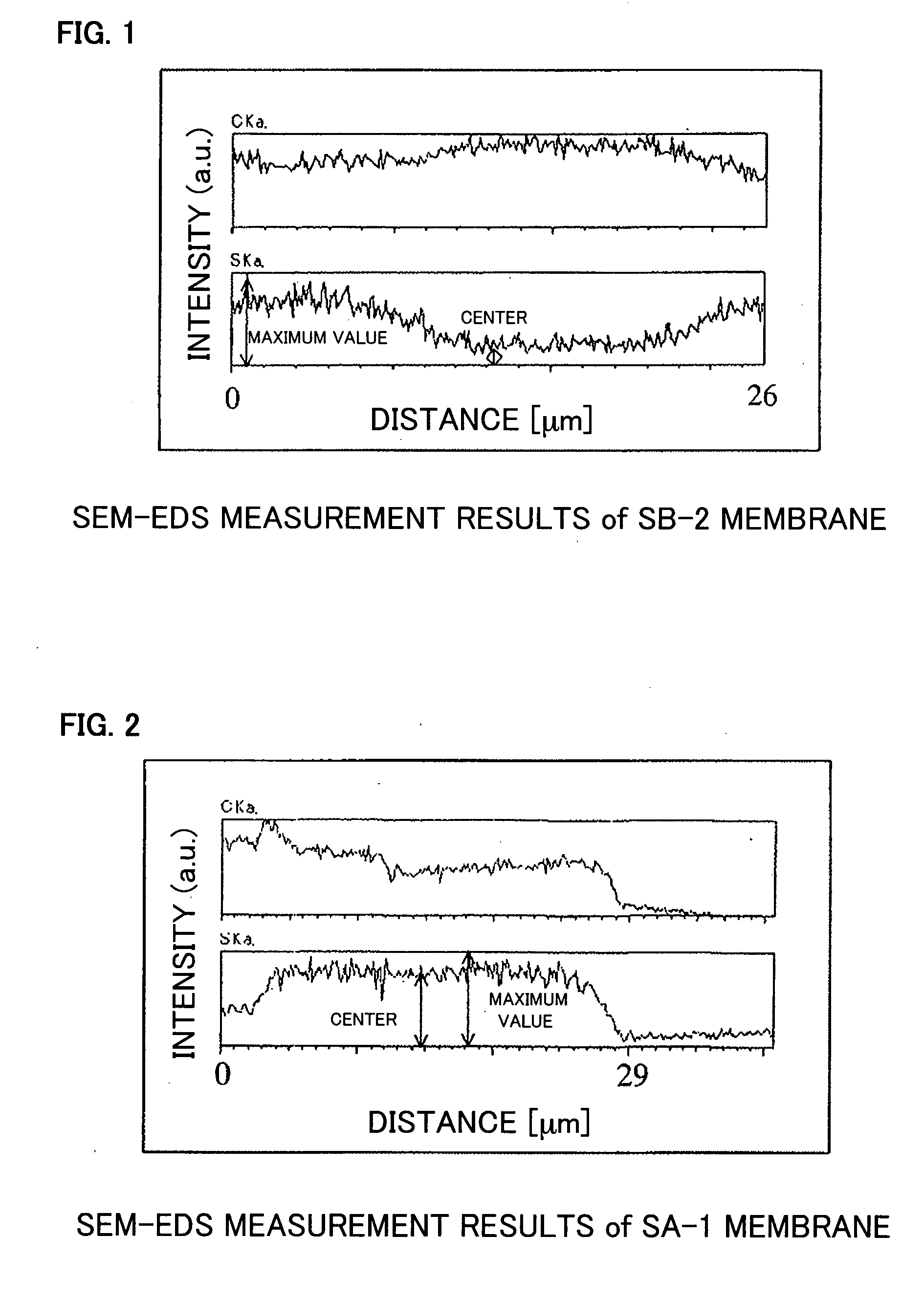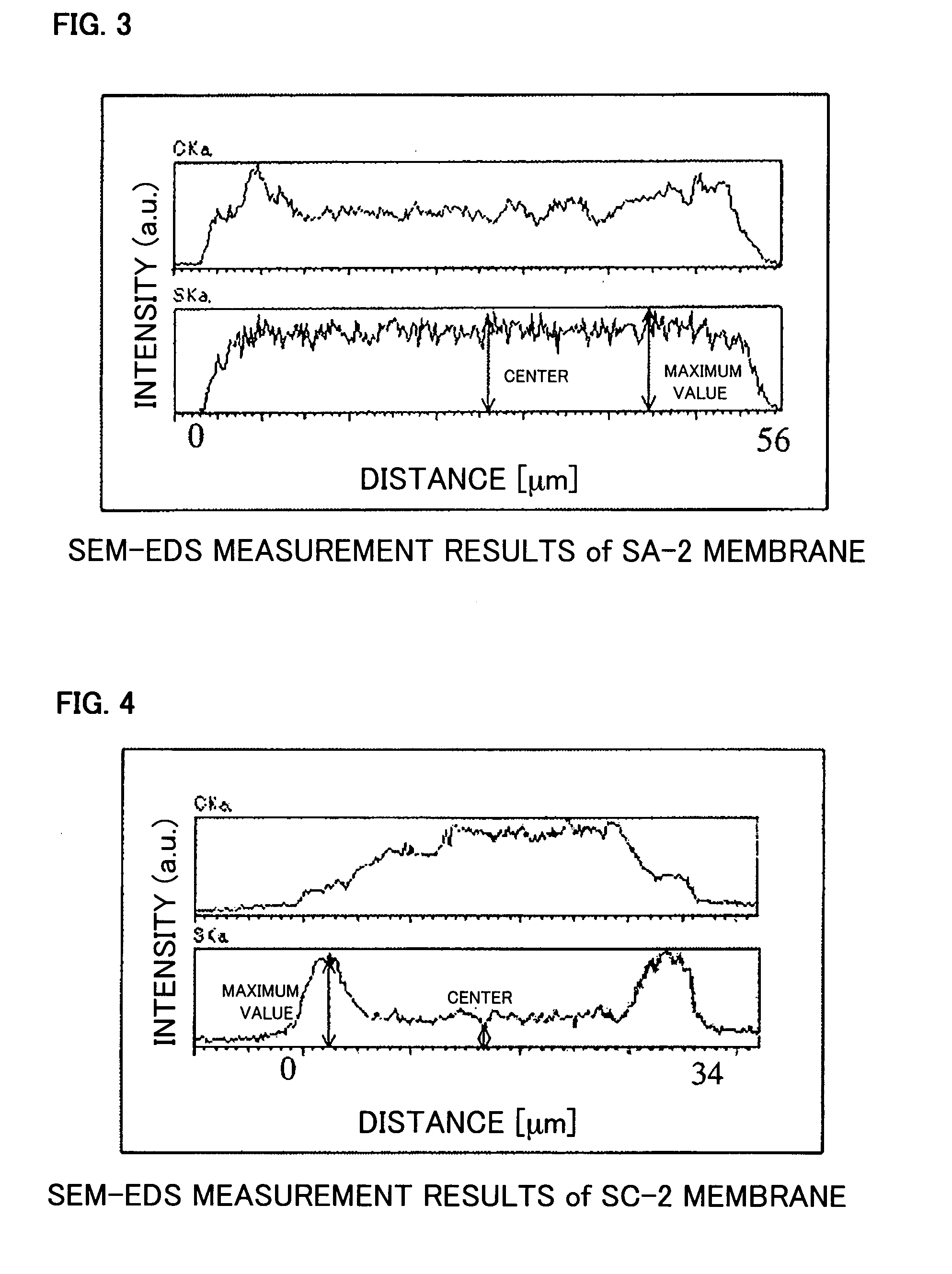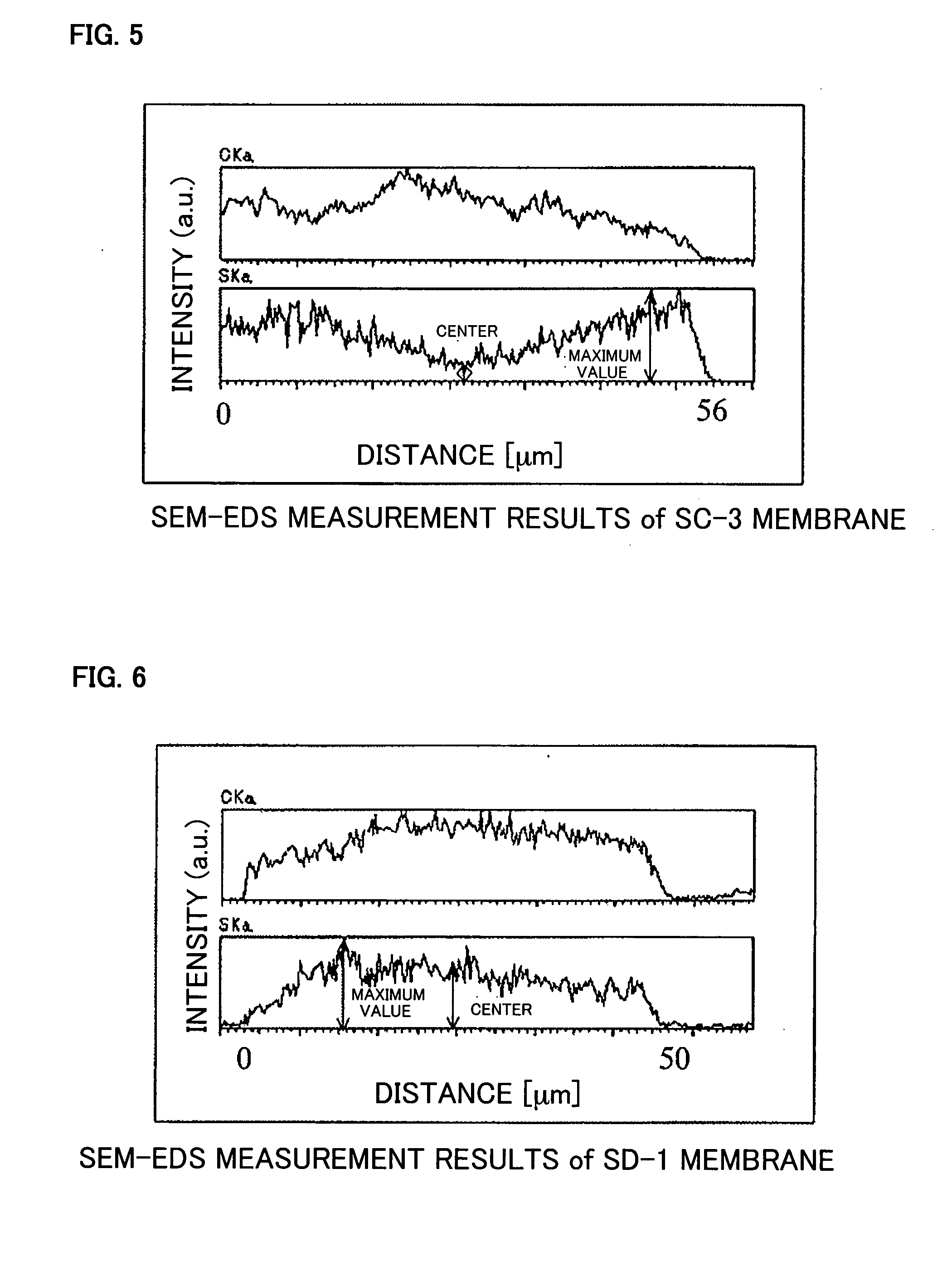Process of producing sulfonic group-containing substituted polyacetylene membrane, membrane obtained thereby and application thereof
a technology of polyacetylene and polyacetylene, which is applied in the direction of sustainable manufacturing/processing, non-metal conductors, cell components, etc., can solve the problems of ethyl acetate, difficult to apply the membrane as a solid electrolyte, and difficult to manufacture into a membrane, etc., to achieve excellent ionic conductivity of a proton (hydrogen), the effect of sufficient membrane strength
- Summary
- Abstract
- Description
- Claims
- Application Information
AI Technical Summary
Benefits of technology
Problems solved by technology
Method used
Image
Examples
example 1
Sulfonation of Membrane A-1 (Synthesis of Membrane SA-1)
[0094] In a 100-mL eggplant type flask, 50 mL of concentrated sulfuric acid (97%) was weighed, and 69 mg of the membrane A-1 was dipped therein and gently stirred at room temperature for 3 hours. After taking out the membrane, it washed with water and further boiled with pure water for one hour. Thereafter, the membrane was dried in vacuo at 110° C. for 16 hours, thereby obtaining a green membrane SA-1. This membrane was subjected to IR measurement. As a result, it was confirmed that a desilylation reaction and a sulfonation reaction proceeded.
[0095] IR, ν (cm−1, KBr disk): 3056 (w, arC-H), 1642 (m, arC-C), 1492 (s, arC-C), 1442 (w), 1218 (s), 1154 (s), 1128 (w, SO3H), 1033 (w, SO3H), 1005 (w), 907 (w), 825 (w), 755 (s), 691 (s), 572 (m).
[0096] The obtained membrane had a thickness of 29 μm, an ion exchange capacity of 2.3 meq / g, a water uptake of 80%, a swelling ratio of 282%, and an ionic conductivity of 3.7×10−1 S / cm (at ...
example 2
Sulfonation of Membrane A-2 (Synthesis of Membrane SA-2)
[0097] In a 100-mL eggplant type flask, 50 mL of a mixed solution of concentrated sulfuric acid (97%) and ethyl acetate (concentrated sulfuric acid / ethyl acetate=80 / 20) was weighed, and 52 mg of the membrane A-2 was dipped therein and gently stirred at room temperature for 16 hours. After taking out the membrane, it washed with water and further boiled with pure water for one hour. Thereafter, the membrane was dried in vacuo at 110° C. for 16 hours, thereby obtaining a green membrane SA-2. This membrane was subjected to IR measurement. As a result, it was confirmed that a desilylation reaction and a sulfonation reaction proceeded.
[0098] IR, ν (cm−1, KBr disk): 3056 (w, arC-H), 1634 (m, arC-C), 1490 (s, arC-C), 1441 (w), 1215 (s), 1159 (s), 1128 (s, SO3H), 1032 (w, SO3H), 1003 (w), 910 (w), 827 (w), 756 (s), 693 (s), 572 (m).
[0099] The obtained membrane had a thickness of 56 μm, an ion exchange capacity of 2.1 meq / g, a water ...
example 3
Sulfonation of Membrane D-1 (Synthesis of Membrane SD-1)
[0109] In a 100-mL eggplant type flask, 50 mL of concentrated sulfuric acid (97%) was weighed, and 49 mg of the membrane D-1 was dipped therein and gently stirred at room temperature for 16 minutes. After taking out the membrane, it washed with water and further boiled with pure water for one hour. Thereafter, the membrane was dried in vacuo at 110° C. for 16 hours, thereby obtaining a green membrane SD-1. This membrane was subjected to IR measurement. As a result, it was confirmed that a desilylation reaction and a sulfonation reaction proceeded.
[0110] IR, ν (cm−1, KBr disk): 3056 (w, arC-H), 1588 (m, arC-C), 1489 (s, arC-C), 1238 (s, arC-O-arC), 1164 (s), 1122 (s, SO3H), 1028 (s, SO3H), 1002 (s), 830 (w), 753 (s), 691 (s).
[0111] The obtained membrane had a thickness of 50 μm, an ion exchange capacity of 1.9 meq / g, a water uptake of 65%, a swelling ratio of 151%, and an ionic conductivity of 8.0×10−2 S / cm (at 90° C. and RH ...
PUM
| Property | Measurement | Unit |
|---|---|---|
| boiling point | aaaaa | aaaaa |
| boiling point | aaaaa | aaaaa |
| size | aaaaa | aaaaa |
Abstract
Description
Claims
Application Information
 Login to view more
Login to view more - R&D Engineer
- R&D Manager
- IP Professional
- Industry Leading Data Capabilities
- Powerful AI technology
- Patent DNA Extraction
Browse by: Latest US Patents, China's latest patents, Technical Efficacy Thesaurus, Application Domain, Technology Topic.
© 2024 PatSnap. All rights reserved.Legal|Privacy policy|Modern Slavery Act Transparency Statement|Sitemap



